Weekly Advanced Technologies〔61〕

Weekly Advanced Technologies〔61〕| Which One Comes First, the Formation of Disks or Halos in the Milky Way? "Pan Gu"Updates Our Perception | AI Unravels the Secrets of "Battery Blood" and Precisely Forecasts the Molecular Properties of Electrolyte
For spiral galaxies like the Milky Way, which possess discs and halos, the question of which formed first, the disks or the halos, is crucial in the exploration of the origin of galaxies and the early - universe environment. Scientific research is gradually getting closer to the truth as conclusions keep "reversing"...
Among the three 2024 Nobel Prize in sciences, two of them have been awarded to artificial intelligence pioneers, producing an unexpected result. Actually, an increasing number of disciplines are reaping the benefits from their intersection with AI. Take the field of chemistry as an example. The electrolyte is known as the "blood of the battery". During the past hundred years, scientists have been committed to continuous exploration through trial-and-error methods, but there are still only dozens of electrolyte molecules that have been widely adopted. Recently, researchers at Tsinghua University have made progress in the field of using artificial intelligence models to predict the properties of battery electrolytes. The knowledge-and data-driven framework for predicting the molecular properties of secondary-battery electrolytes developed by them has greatly improved the prediction efficiency.
Based on the weekly diary of technology provided by the daily list of the NCSTI online service platform, we launch the column "Weekly Advanced Technologies" at the hotlist of sci-tech innovation. Today, let's check out No.61.
1. Nature Astronomy丨Which One Comes First, the Formation of Disks or Halos in the Milky Way? "Pan Gu" Updates Our Perception
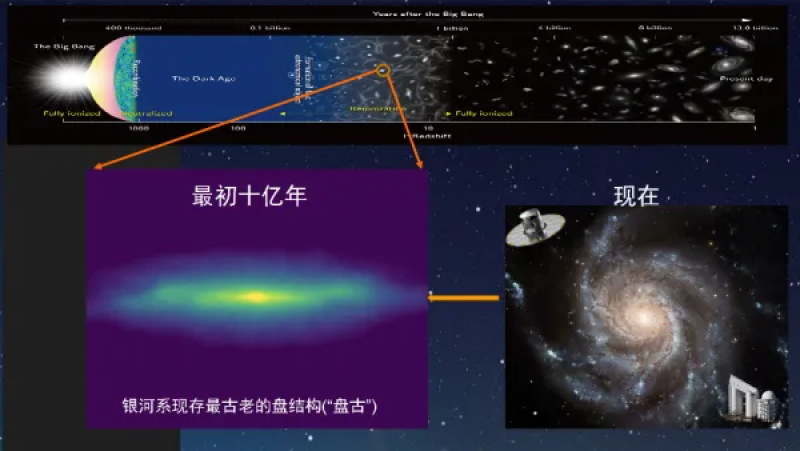
Imagination of the very early Milky Way
For spiral galaxies like the Milky Way, which possess discs and halos, the question of which formed first, the disks or the halos, is crucial in the exploration of the origin of galaxies and the early - universe environment. Scientific research is gradually getting closer to the truth as conclusions keep "reversing"...
Dark energy and cold dark matter models were once in vogue. This model predicts a turbulent early - universe environment, where galaxies frequently and violently cannibalize and merge with one another. This may have made it challenging for an early galactic disk to exist and be maintained. Observationally, most of the extragalactic disk galaxies discovered in the past have a redshift of less than 3 (redshift is the phenomenon in which the frequency of an object's electromagnetic radiation decreases for certain reasons, and the redshift is proportional to the distance). Regarding the Milky Way, it is generally held that the halo is the oldest structure in the Milky Way, while the disk formed later than the halo, approximately 10 billion years ago.
However, in recent years, the James Webb Space Telescope has discovered that galaxy disks can exist at much higher redshifts. Even in galaxies with redshifts exceeding 5, the disk structure remains prevalent. Likewise, studies on galactic stellar chemokinematics data have indicated that some older metal-poor stars possess orbital kinematics similar to those of relatively metal-rich galactic disk stars, implying that galactic disks might have emerged earlier.
Recently, institutions from China and other countries such as the National Astronomical Observations of Chinese Academy of Sciences and the Max Planck Institute for Astronomy have jointly carried out research. Based on the LAMOST and Gaia survey data, they have obtained the largest and most accurate sample of stellar ages so far. Combined with statistical modeling, they have reconstructed the evolution of the spatial distribution structure of galactic disk stars with age, and found that the spatial distribution of extremely ancient stars with an age of 13 - 13.5 billion years presents a clear disk structure.
This suggests that the ancient galactic disks began to form within a few hundred million years of the birth of the Universe and have survived the subsequent evolution of galaxies over more than 13 billion years, which is the earliest known disk structure than the one previously observed by the James Webb Space Telescope. This early formed Galactic disks component has been named "Pan Gu" (盘古) after the disk structure previously observed by the James Webb Space Telescope, and is the earliest known galactic disk. The study concludes that the stellar mass of the disk is about 2 × 109 times the solar mass, which is larger than the stellar mass of the early silver halo, suggesting that the disk may have been the dominant structure in the very early Milky Way.
This work is of great significance for analyzing the structural evolution of the early Milky Way. The research has discovered that over the more than five billion years from 80 to 13.5 billion years ago, the structural evolution of the ancient galactic disk mainly took place in the direction perpendicular to the galactic disk plane. And this evolutionary effect may be determined jointly by the vertical cooling mechanism of star-forming gas and the vertical heating mechanism of stars. Through comparison with the numerical simulation data of galactic fluids, the research has found that the actual galactic disk is thinner than that in the numerical simulation, which indicates that the early evolutionary environment actually experienced by the Milky Way is more peaceful than theoretically expected.
2 . Angew. Chem. Int. Ed丨AI Unravels the Secrets of "Battery Blood" and Precisely Forecasts the Molecular Properties of Electrolyte
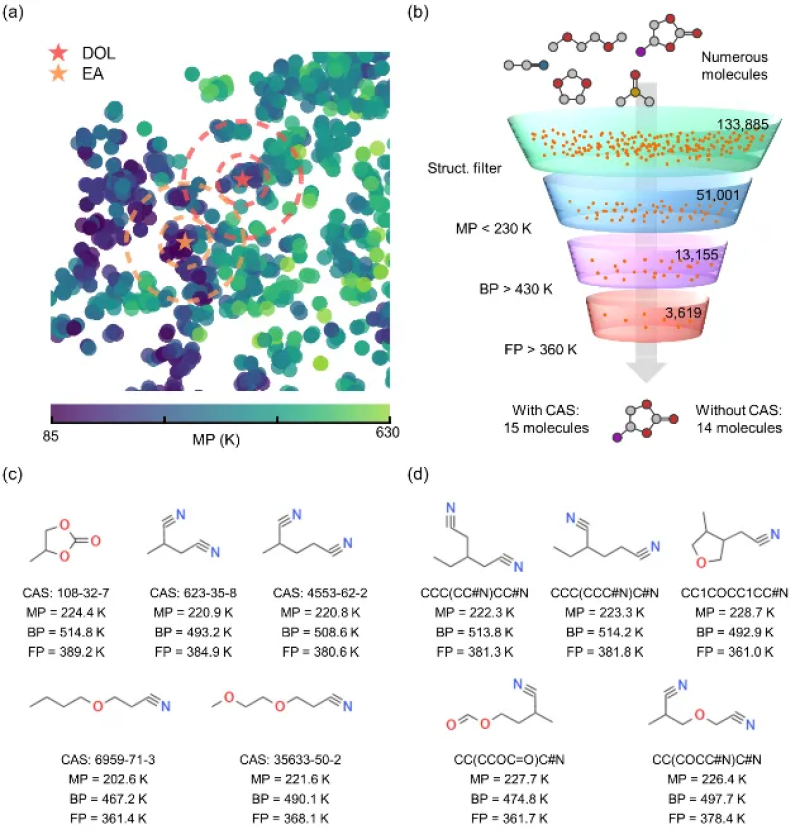
KPI framework guides electrolyte molecular design
Among the three 2024 Nobel Prize in sciences, two of them have been awarded to artificial intelligence pioneers, producing an unexpected result. Actually, an increasing number of disciplines are reaping the benefits from their intersection with AI. Battery consists of three parts: positive electrode, negative electrode and electrolyte. Among them, the electrolyte is known as the “blood of the battery”, and the physical and chemical properties of the electrolyte directly affect the performance of the battery. Therefore, in-depth study and attention to the nature of the electrolyte is crucial. However, the electrolyte molecules have a wide variety of components and types, and in the past hundred years, only dozens of electrolyte molecules have been widely adopted, despite the fact that researchers have been exploring and studying them through trial and error.
Aiming at the lack of critical physical property data for advanced electrolyte design, the group of Chen Xiang and Zhang Qiang at Department of Chemical Engineering, Tsinghua University has conducted a series of innovative researches and achieved a number of results. Recently, they developed A knowledge–data dual-driven framework for Predicting the Molecular Properties of Rechargeable Battery Electrolytes, the Knowledge-based electrolyte Property prediction Integration (KPI), in which a large amount of data on the structure and properties of electrolyte molecules are first collected and organized into a structured dataset automatically. Through interpretable machine learning algorithms, the framework explores the molecules' conformational relationships from a microscopic point of view and embeds this discovered knowledge into the final prediction model.
The KPI framework attained low mean absolute errors (MAE) of 10.4, 4.6, and 4.8 K respectively in the prediction of melting, boiling, and flash points. Moreover, the KPI achieved high-quality predictions in 18 out of the 20 tested datasets. Through molecular nearest-neighbor search and high-throughput screening, the team also successfully predicted 29 molecules that are potentially applicable to battery scenarios with a wide temperature range and high safety. Some of these molecules have been proven in the literature to possess excellent properties, which provides important guidance for the intelligent design of electrolyte molecules.
The framework accurately predicts the key properties of electrolyte molecules and deepens the understanding of molecular conformational relationships. Moreover, it sets a new standard for the development of deep-learning models by organically combining the discovery and embedding of chemical knowledge, which greatly improves the performance of AI methods in real-world applications. Consequently, it provides strong support for research and development in batteries and other related fields.
3 . Nature Communications丨Research Teams Uncover the "Invisible Killer" in the Sky, Enabling Aircraft to Bid Farewell to the "Dance on the Knife-edge"
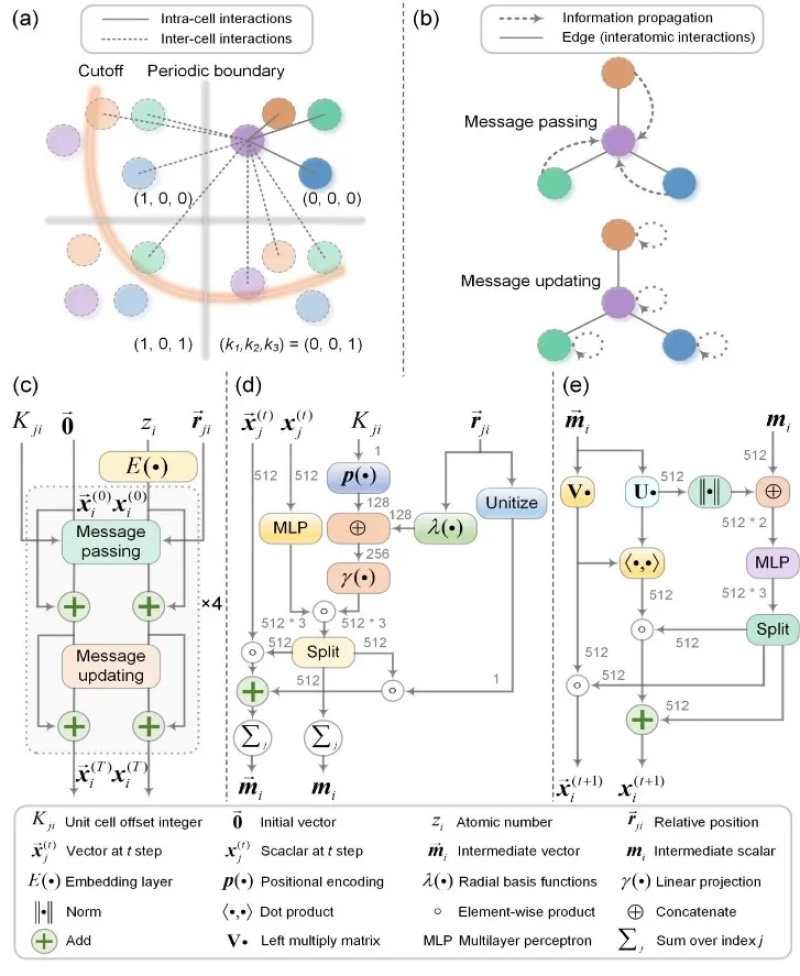
Schematic diagram of the integrated assessment method for aviation hazards in low-altitude wind farms based on interpretable semi-supervised clustering
A wind field refers to an area within a certain range where local factors such as wind speed and wind direction are not uniform. It is the most common natural phenomenon and is closely related to our production and life. Complex wind fields such as aircraft wake vortices and wind shear are the leading factors in more than 40% of major aviation disasters and are known as the "invisible killers" in the air. The take - off and landing of carrier - based aircraft are even more likened to "dancing on the tip of a knife" due to the influence of complex wind fields and so on.
The complexity of the wind field lies in the fact that it is influenced by a combination of factors such as terrain, geomorphology, and meteorological conditions. It exhibits multi - scale and chaotic dynamics in terms of spatial and temporal distributions and is highly coupled with the aerodynamic characteristics of aircraft, which makes it difficult to identify aviation hazards in complex wind fields. Existing international hazard detection standards are often customized for different wind field types (for example, wind shear, turbulence, aircraft wake, etc.), geographical locations, and meteorological conditions. This is similar to designing different rulers to measure different objects. Such standards have limited validity and versatility and are prone to overlooking other aspects. How to find an accurate ruler to uniformly measure the aviation hazards of complex wind fields has long been a challenge in the field of aviation safety.
To address this problem, the LI Jian Corps team of the School of Electronic Science at the National University of Defense Technology pioneered an integrated assessment method of aviation hazards in low-altitude wind fields based on interpretable semi-supervised clustering, which provides fundamental theoretical support for improving aviation safety and security. Starting from the essence that spatial non-uniformity of wind field triggers aviation hazards, and combining the a priori knowledge of wind field physics and probabilistic models, the team proposed an integrated assessment method of aviation hazardous wind field based on interpretable semi-supervised clustering, which discovered the general high-dimensional features of aviation hazards of low-altitude wind field under the condition of a large amount of radar detection data and a very small amount of labeled data, and realized the high-confidence identification and quantitative assessment of multiple types of hazardous wind fields for the first time. The first high-confidence identification and quantitative assessment of multiple types of hazardous wind fields is realized.
4. Nature Communications丨The Latest Machine - Learning Model Speeds up Crystal Structure Optimization.
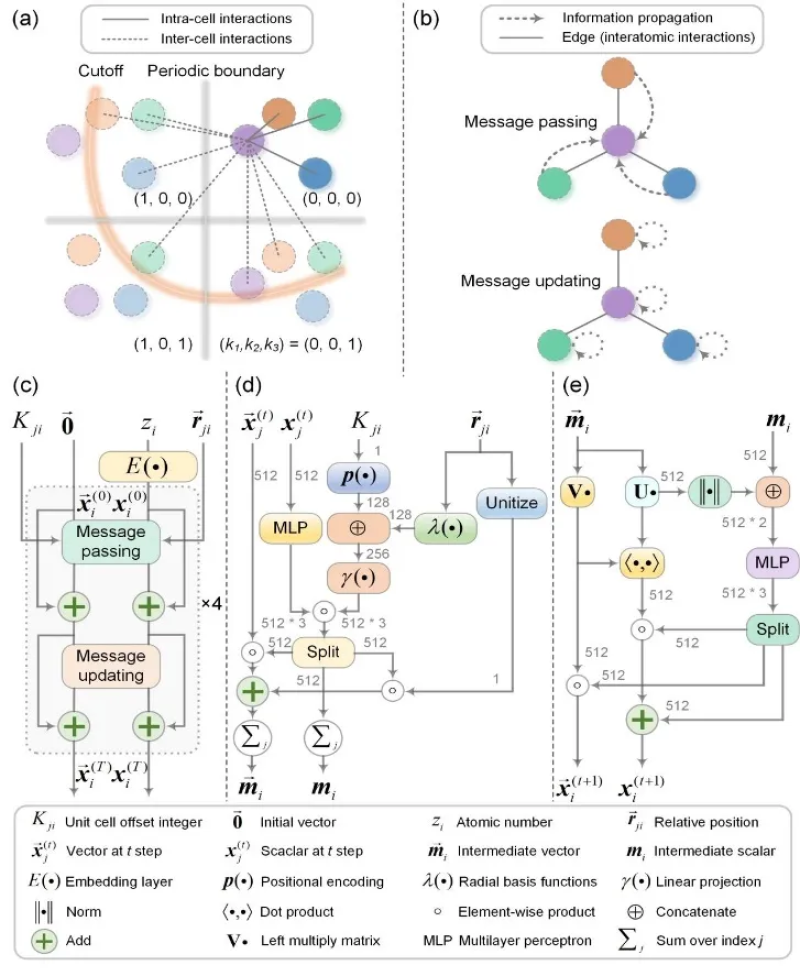
The model structure of DeepRelax
Atomic or crystal structure optimization finds extensive applications in fields like computational chemistry, computational physics, and computational materials science. The primary objective of structure optimization is to identify the lowest-energy state, which is also known as the ground state. The ground-state structure serves as the foundation for calculating and predicting physical and chemical properties. This process is crucial for applications such as surface chemical reactions, crystal defect modulation, and drug design.
A scientific collaboration has been launched by Peking University Shenzhen Graduate School, School of Intelligence Science and Technology (Peking University), and National University of Singapore. They have jointly developed a machine learning model, DeepRelax. The model directly forecasts a more stable structure compared to the initial one via a single-step calculation, thus circumventing the computational bottleneck in Density Functional Theory (DFT), which demands iterative calculations of electron density and total energy. The team further utilized DFT to optimize the structures predicted by DeepRelax for the purpose of achieving rapid convergence. DeepRelax is capable of optimizing a crystal structure within a few hundred milliseconds by using a single A6000 GPU. Moreover, DeepRelax also has the capacity to optimize structures in parallel, a characteristic that renders it valuable for high - throughput materials screening and computation.
5. ACS Sensors丨The "customized" transcriptional factor biosensors emerge as the times require for Industry 4.0.
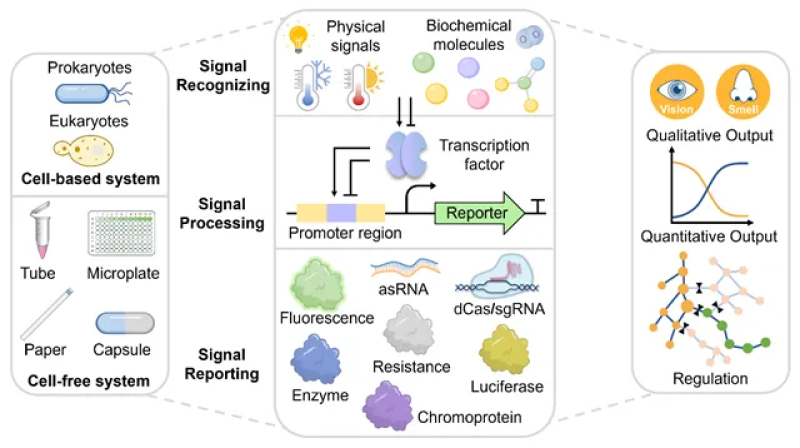
Overview of transcription factor biosensors
Industry 4.0 refers to the use of information technology to promote industrial change, emphasizing the integration of smart factories, smart production and smart logistics, in order to promote the transformation of the traditional manufacturing industry from mass production to personalized customization, and ultimately make the production process more flexible, personalized and customized. What biotechnologies are emerging for Industry 4.0 nowadays?
The flourishing biotechnology economy depends on the continuous progress of biological tools and techniques. The improvement in DNA synthesis in terms of cost - effectiveness, component standardization, and the development of computer algorithm technology has made a significant contribution to the application of diverse genetic components in biosensor development. Transcription factor (TF)-based biosensors (TFBs) have attracted a great deal of attention because of their modularity, versatility, integratability and customizability.
TF is essentially a regulatory protein with special structures and functions, and its conformational change occurs in response to specific biological signals. Organisms regulate metabolic fluxes and maintain the balance of the overall metabolic network with the help of TF - mediated regulation. After recognizing the input ligand, TF can bind to or dissociate from the TF - binding region (TFBR) within or near the paired promoter region. This interaction regulates the transcription of downstream genes by influencing the binding of RNA polymerase (RNAP) to the promoter. Based on its sensing properties, TF is widely used to develop cell-based or cell-free biosensing systems for molecular detection or pathway regulation.
A recent article by HUO Yixin's group at Beijing Institute of Technology reviews the mechanisms and construction principles of transcription factor biosensors, their applications in biotechnology, and strategies for performance-oriented improvements in response. This encompasses engineering strategies for customizing specific functional and performance parameters of TFBs and even achieving the functional inversion of activation and repression. They also thoroughly discuss the systematic enhancement of TFB performance by modifying the constituent elements of TFBs, as well as the progress of TFBs with the aid of multi- / inter-disciplinary collaborations, such as phenomenological modeling, deep-learning-based protein structure prediction, DNA functional sequence prediction, and protein ab initio design.
The paper puts forward future directions for TFBs in developing fast - response biosensors and addressing application isolation challenges. It also examines the potential of artificial intelligence techniques and various models for programming TFB genetic circuits, and offers technical suggestions and fundamental guidance for constructing and designing TFBs, thus promoting a broader range of applications of TFBs in Industry 4.0, such as smart biofabrication, environmental and food contaminant detection, and medical science fields.
6. Nature Communications丨The Mystery of Spinal Cord Injury Remains Unresolved? Microglia Turns into "Guardians" and Bring Hope for Treatment
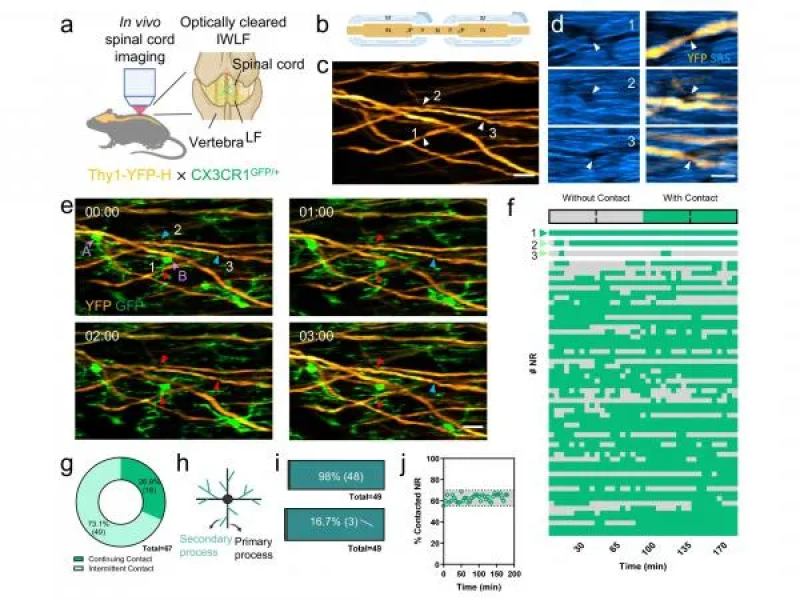
Spinal cord injury may lead to severe consequences, like lifelong paralysis. However, the scientific community has not fully grasped its mechanisms yet, and consequently, has not been able to find effective treatments. For a long time, due to the absence of suitable in vivo imaging techniques, scientists have been unable to accurately observe and study the undisturbed cellular biological processes in the spinal cord.
To surmount this challenge, an interdisciplinary team led by Professor Qu Chia - nam from the Department of Electrical and Computer Engineering in the Faculty of Engineering, and Professor Kai Liu from the Division of Life Sciences in the Faculty of Science at The Hong Kong University of Science and Technology has disclosed a protective mechanism for spinal cord neurological injuries. This mechanism offers an innovative direction in the development of therapeutic treatments, which are expected to benefit over tens of millions of patients globally.
By combining multimodal microimaging and optical clearance techniques, they, for the first time in the international field, demonstrated the interaction between glial cells and nodes in the spinal cord under natural physiological conditions. They successfully achieved minimally invasive in vivo imaging, and thus found that microglial cells perform a special function after spinal cord axon injury and effectively prevent axon degeneration.
Columnist: Li Xiaoxiao
Translator: Liu Kaiyuan